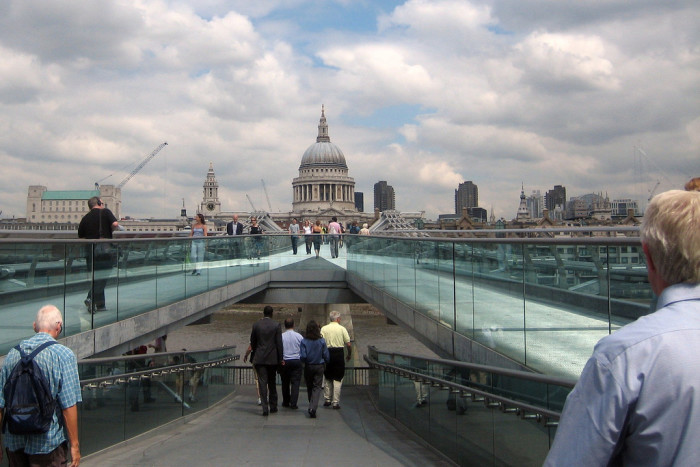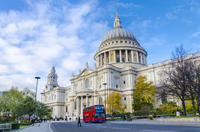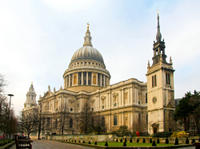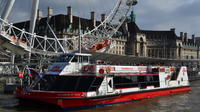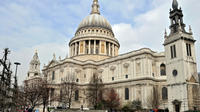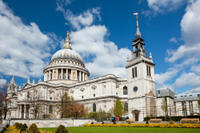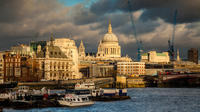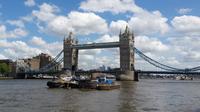St Paul's Cathedral ★★☆
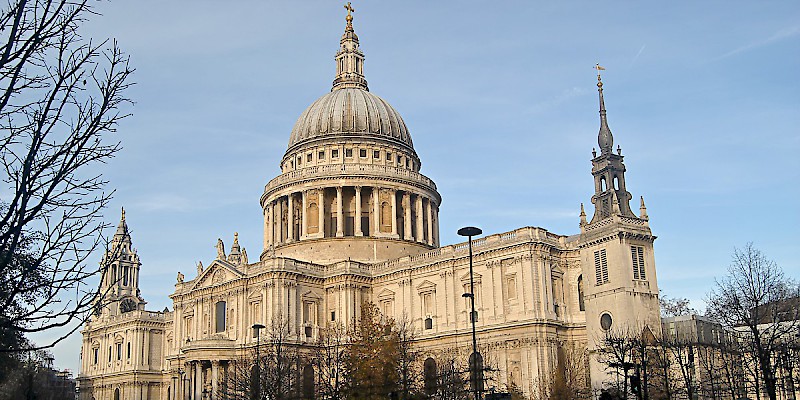
Christopher Wren’s architectural Renaissance masterpiece has stupendous views from its famous dome, and famous Brits buried in the crypt.
Christopher Wren’s architectural Renaissance masterpiece, St. Paul’s Cathedral, stood alone during the infamous Blitz, (virtually) untouched by the Nazi air raid bombings and fires that ravaged the city.
Captured on newsreel footage, the image of the grand church’s survival became a rallying point for Britain’s pride and indomitable spirit during the darkest days of World War II.
(Truth be told, however, the pilots of the Blitz were very careful not to bomb St. Paul's, as its dome served as the perfect landmark for their bombing runs.)
The main Great West Doors stand nine meters (30 feet) tall, and are only opened for special services and state occasions to receive the Queen or Lord Mayor of London.
The Nave and transepts
Two-thirds of the way up the nave, on the left, is a 1912 memorial to Arthur, Duke of Wellington, the national hero who defeatred Napoleon at Waterloo (his actual tomb is in the crypt; see below).
In the south (right) transept is a monument Britiain's other great 19th century military hero, Lord Admiral Horatio Nelson, who died at Trafalgar in 1805. Also here are monuments to JMW Turner and Capt. Robert Scott, the mighty yet tragic explorer who reached the South Pole just days after his Norwegian rival Amundsen, then died on the way back.
The quire and apse
The Grand Organ—third largest in the U.K., most reliably played on Sundays at the 4:45pm Organ Recital—dates to 1695 (restored many times since), featuring 7,189 pipes, 138 stops, and five keyboards. Beyond stretched the Quire, where the clergy and choir sit for services, with stalls carved by Grinling Gibbons and a cathedra (bishop's throne—which is why these grand churches that serve as metaphical seats for bishoprics are called "cathedrals").
Flanking the quire are still more monuments and memorials, including in teh north qurie aisle one of Henry Moore's final marble sculptures, a curvaceous 1980s Mother and Child; and in the south qure aisle a memorial to John Donne, the early 17th century Dean of the Cathedral and a master poet (you can still see some scorch marks on it from the 1666 Great Fire of London).
Beyond the High Altar is the Apse, the only part of the cathedral destroyed during the Blitz. Rebuilt to house the Jesus Chapel, dedicated to the 28,000 Americans stationed in the UK. during World War II, its stained glass, metalwork, and carved wood decorated with images of North American flora and fauna (also: a rocketship).
The crypt
In the crypt are buried some of those heroes memorialized above, including the Duke of Wellington and Lord Nelson; the great painters Constable, Turner, and Reynolds; Alexander Fleming, the scientist who discovered penicillan; the sculptor Henry Moore; the adventurer/hero T. E. Lawrence (better known as Lawrence of Arabia); and compioser Arthur Sullivan of Gilbert and Sullivan fame (you know: "The Major-General's Song," "For He is an Englishman," "Three Little Maids for School Are We," plus he wrote "Onward Christian Soldiers"... and now that I have gotten all of those stuck in you head, let's move on).
Also here is the cathedral's architect, Christopher Wren, whose simple tombstone bears a Latin epithaph that translates as: "Reader, if you seek his monument, look around you."
The dome of St. Paul's
Visitors can climb the 111m (364-foot) dome that glitters with mosaics.
Pause 257 steps (30m/98 feet) up to enjoy the acoustic effects of the Whispering Gallery—murmur against the wall and someone 158 feet away on the opposite side can hear you.
After 376 steps (52m/171 feet) you reach the Stone Gallery, at the base of the dome itself, with your first low views across London.
Die-hards will continue the full 528 steps (85m/279 feet) to the Golden Gallery—at the base of the cupola, just beneath the 23-foot-high ball and lantern—for the magnificent 360-degree panorama of London.
TicketsTips
Assuming you are willing to pay the high admission, make it work your while and give St. Paul's at least 90 minutes—especially if you intend to climb the dome.
Note that, while the church doors open at 8:30am, the dome galleries do not open until 9:30am.
The last entry tickets are sold at 4pm, with the last entrance to the dome galleries at 4:15pm.
Included with your admission price is one of two tours. I'd arrange to visit in time to take advantage of the more complete guided tour below:
- Introductory talk (15–20 min) - Quick overview offered thoughout the day.
- Guided tour (90 min) - These far more complete tours give you plenty of background, and even better get you into bits of St. Paul's normally closed to the public. They leave daily at 10am, 11am, 1pm, and 2pm.
The admission to St. Paul's is breathtakingly steep for a sight that—while admittedly grand and certainly famous—does not really offer all that much.
If you are on a tight budget, I would actually skip St. Paul's (unless you happen to have the London Pass or iVenture Card, both of whcih get you in for free).
Check the website for up-to-date schedules, but in general the regular schedule of services at St Paul's is:
Sundays
- 8am - Holy Communion
- 10:15am - Choral Matins
- 11:30am - Sung Eucharist
- 3:15pm - Choral Evensong
- 4:45pm - Sunday Organ Recital




